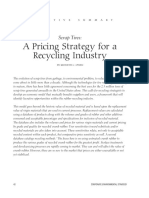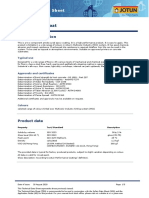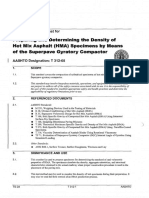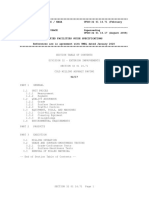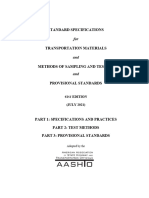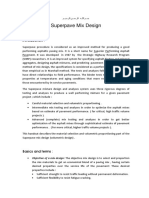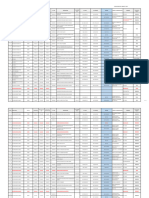Professional Documents
Culture Documents
WSDOT Errata To FOP For AASHTO T 312
WSDOT Errata To FOP For AASHTO T 312
Uploaded by
Warner MnsjOriginal Description:
Original Title
Copyright
Available Formats
Share this document
Did you find this document useful?
Is this content inappropriate?
Report this DocumentCopyright:
Available Formats
WSDOT Errata To FOP For AASHTO T 312
WSDOT Errata To FOP For AASHTO T 312
Uploaded by
Warner MnsjCopyright:
Available Formats
WSDOT Errata to FOP for AASHTO T 312
Preparing and Determining the Density of Asphalt Mixture Specimens by Means of the
Superpave Gyratory Compactor
WAQTC FOP for AASHTO T 312 has been adopted by WSDOT with the following changes:
Equipment Preparation
Include bullet below:
• Pre-heat molds and plates in the oven set no more than 25° F above the compaction
temperature shown on the mix design report.
Sample Preparation
Plant Produced Asphalt Mixtures
Replace step 3 with below:
3. Place in the oven until the material is 5° F above the compaction temperature shown on the
mix design report.
Compaction Procedure
Replace step 3 with below:
3. Remove the pan of Asphalt Mixture from the oven and in one motion invert the pan onto
the construction paper, vinyl mat, etc. Quickly remove any material that remains in the pan
and include it with the Asphalt Mixture sample to be compacted. Grasp opposing edges
of the paper and roll them together to form the Asphalt Mixture into a cylindrical shape.
Insert one end of the paper roll into the bottom of the compaction mold and remove the
paper as the Asphalt Mixture slides into the mold. This process needs to be accomplished in
approximately 60 seconds. Place the mixture into the mold in one lift. Care should be taken
to avoid segregation in the mold.
WSDOT Materials Manual M 46-01.42 Page 1 of 8
January 2023
T 312
Page 2 of 8 WSDOT Materials Manual M 46-01.42
January 2023
T 312
ASPHALT II WAQTC FOP AASHTO T 312 (22)
PREPARING AND DETERMINING THE DENSITY OF ASPHALT MIXTURE
SPECIMENS BY MEANS OF THE SUPERPAVE GYRATORY COMPACTOR
FOP FOR AASHTO T 312
Scope
This procedure covers preparing specimens, using samples of plant produced asphalt
mixtures, for determining the mechanical and volumetric properties of asphalt mixtures in
accordance with AASHTO T 312-22.
Apparatus
Superpave Gyratory Compactor (SGC) meeting the requirements of AASHTO
T 312
Molds meeting the requirements of AASHTO T 312
Chute, mold funnel or both (Optional)
Scale meeting the requirements of AASHTO M 231 Class G 5
Oven, thermostatically controlled, capable of maintaining set temperature within ±3ºC
(±5ºF)
Thermometers with a temperature range of at least 10 to 230°C (50 - 450°F) and accurate
to ±1ºC (±2°F)
Note 1: Non-Contact thermometers are not acceptable.
Miscellaneous pans, spoons, spatulas, hot pads, gloves, paper discs, markers, etc.
Equipment Requirements
The calibration shall be performed on the SGC per the Manufacturer’s instructions. See
agency requirements for the calibration frequency.
The mold and base plate dimensions shall be checked every twelve months or 80 hours of
operation to determine that they are within the tolerances listed in AASHTO T 312.
Equipment Preparation
Prepare the equipment in accordance with manufacturer’s recommendations. At a minimum
preparation includes:
Warm-up gyratory compactor
Verify machine settings
- Internal Angle: 1.16 0.02
- Ram Pressure: 600 kPa 18 kPa
53_T 312_short_22_errata Asphalt II 21-1 Pub. October 2022
WSDOT Materials Manual M 46-01.42 Page 3 of 8
January 2023
T 312
ASPHALT II WAQTC FOP AASHTO T 312 (22)
- Number of gyrations
Note 2: The number of gyrations (Ndes) is obtained from the Job Mix Formula (JMF).
Lubricate bearing surfaces
Prepare recording device as required
Pre-heat molds and plates at the compaction temperature range (minimum of 30 min.) or
before reuse reheat (minimum of 5 min.)
Note 3: The use of multiple molds will speed up the compaction process.
Pre-heat chute, mold funnel, spatulas, and other apparatus (not to exceed the maximum
compaction temperature)
Sample Preparation
Laboratory Prepared Asphalt Mixtures
This is a sample produced during the Mix Design process using aggregate and binder that is
combined in the laboratory. When designing asphalt mixtures using the gyratory compactor,
refer to AASHTO T 312 and AASHTO R 35.
Plant Produced Asphalt Mixtures
Determine initial sample size, number of gyrations (Ndes), and compaction temperature
range from the Job Mix Formula (JMF).
Obtain the sample in accordance with the FOP for AASHTO R 97.
Reduce the sample in accordance with the FOP for AASHTO R 47.
The sample size should be such that it results in a compacted specimen that is 115 ±5 mm
at the desired number of gyrations.
Note 4: Replicate specimens are generally prepared. Refer to agency requirements.
If the material is not in the compaction temperature range:
1. Place the appropriate sample mass into a container.
2. Spread to a depth of 1 to 2 in. for even heating of mixture.
3. Place in the oven until the material is within the compaction temperature range.
Note 5: The material properties may be altered when the times of delivery of the test sample and the placement
of the material on the roadway are different.
53_T 312_short_22_errata Asphalt II 21-2 Pub. October 2022
Page 4 of 8 WSDOT Materials Manual M 46-01.42
January 2023
T 312
ASPHALT II WAQTC FOP AASHTO T 312 (22)
Compaction Procedure
Follow the manufacturer’s recommended loading procedure. This may require the steps
below to be performed in a different order. Steps 1 through 8 must be performed before the
sample and mold cools below minimum compaction temperature.
1. Remove pre-heated mold and plate(s) from the oven (verify mold and plate(s) has been
cleaned if previously used).
2. Place the base plate and paper disc in bottom of mold.
3. Place the mix into the mold in a single lift (care should be taken to avoid segregation or
loss of material).
4. Level the mix in the mold.
5. Place a paper disc and the heated upper plate (if required) on top of the leveled sample.
6. Load the mold into the compactor, check settings.
7. Start the compaction process.
a. Check the pressure (600 ±18 kPa).
b. Check the angle (1.16 ±0.02°).
8. Extrude the specimen from the mold; a brief cooling period may be necessary before
fully extruding some specimens to ensure the specimens are not damaged.
Note 6: Clean molds after each use.
9. Upon completion of the compaction process, record the number of gyrations and
specimen height.
Note 7: If the specimen is not 115 ±5 mm, follow agency requirements.
10. Carefully remove the paper discs.
11. Cool the compacted specimen to room temperature.
12. Identify the specimen with chalk or other marker.
Report
On forms approved by the agency
Sample ID
Number of gyrations
Specimen height to the nearest 0.1 mm
53_T 312_short_22_errata Asphalt II 21-3 Pub. October 2022
WSDOT Materials Manual M 46-01.42 Page 5 of 8
January 2023
T 312
ASPHALT II WAQTC FOP AASHTO T 312 (22)
53_T 312_short_22_errata Asphalt II 21-4 Pub. October 2022
Page 6 of 8 WSDOT Materials Manual M 46-01.42
January 2023
T 312
ASPHALT II WAQTC FOP AASHTO T 312 (20)
PERFORMANCE EXAM CHECKLIST
PREPARING AND DETERMINING THE DENSITY OF ASPHALT MIXTURE
SPECIMENS BY MEANS OF THE SUPERPAVE GYRATORY COMPACTOR
FOP FOR AASHTO T 312
Participant Name ____________________________________ Exam Date ______________
Record the symbols “P” for passing or “F” for failing on each step of the checklist.
Procedure Element Trial 1 Trial 2
1. Angle, pressure and number of gyrations set? _____ _____
2. Bearing surfaces, rotating base surface, and rollers lubricated? _____ _____
3. Representative sample obtained according to the FOP for AASHTO R 97? _____ _____
4. Sample reduced according to FOP AASHTO R 47? _____ _____
5. Sample placed in a container and spread to 1 or 2 inches thick for
even heating? _____ _____
6. Asphalt mixture heated to compaction temperature range? _____ _____
7. Mold, base plate, and upper plate heated to compaction temperature range? _____ _____
8. Mold, base plate, and upper plate (if required) removed from oven and
paper disk placed on bottom of mold? _____ _____
9. Mix placed into mold in one lift without segregation? _____ _____
10. Paper disk placed on top of the asphalt mixture? _____ _____
11. Mold placed into compactor and upper plate clamped into place? _____ _____
12. Pressure applied at 600 kPa ±18 kPa? _____ _____
13. Specified number of gyrations applied? _____ _____
14. Proper angle confirmed from display? _____ _____
15. Compacted specimen removed from mold, paper disc(s) removed, and
allowed to cool to room temperature? _____ _____
16. Asphalt mixture sample measured to a height of 115 ±5 mm at required
gyrations? _____ _____
Comments: First attempt: Pass Fail Second attempt: Pass Fail
Examiner Signature _______________________________WAQTC #:_______________
41_T312_pr_20 Asphalt II 11-9 Pub. October 2022
WSDOT Materials Manual M 46-01.42 Page 7 of 8
January 2023
T 312
ASPHALT II WAQTC FOP AASHTO T 312 (20)
41_T312_pr_20 Asphalt II 11-10 Pub. October 2022
Page 8 of 8 WSDOT Materials Manual M 46-01.42
January 2023
You might also like
- Aashto r46 - SmaDocument12 pagesAashto r46 - SmaKleberson Ramos100% (1)
- Aashto T 283-2021Document10 pagesAashto T 283-2021yasir mohammedNo ratings yet
- Aashto T 283-2021Document10 pagesAashto T 283-2021yasir mohammedNo ratings yet
- Aashto R35Document31 pagesAashto R35safak kahramanNo ratings yet
- Shotcrete RequirementsDocument16 pagesShotcrete Requirementstinz_3100% (2)
- Method Statement For GroutingDocument43 pagesMethod Statement For GroutingMohd Syaril Mohd Ali100% (5)
- CE 310 - Transportation Engineering - I: Introduction To Bituminous MixDocument19 pagesCE 310 - Transportation Engineering - I: Introduction To Bituminous MixShre BNo ratings yet
- Refractory ProcedureDocument13 pagesRefractory ProcedureArunachalam Avanashi100% (3)
- Specifications From Tarura RegionDocument92 pagesSpecifications From Tarura RegionEdsony NyamwelaNo ratings yet
- A Pricing Strategy For A Recycling Industry: Scrap TiresDocument9 pagesA Pricing Strategy For A Recycling Industry: Scrap TiresBen GuhmanNo ratings yet
- Hot Mix Asphalt (Hma) Specimens by Means of The Superpave Gyratory Compactor Fop For Aashto T 312Document4 pagesHot Mix Asphalt (Hma) Specimens by Means of The Superpave Gyratory Compactor Fop For Aashto T 312Aldrin SantosNo ratings yet
- FOP For AASHTO T 312Document6 pagesFOP For AASHTO T 312Warner MnsjNo ratings yet
- WSDOT Errata To FOP For AASHTO T 308: Determining The Asphalt Binder Content of Asphalt Mixtures by The Ignition MethodDocument16 pagesWSDOT Errata To FOP For AASHTO T 308: Determining The Asphalt Binder Content of Asphalt Mixtures by The Ignition MethodPramod KumarNo ratings yet
- STR For Composite GRSP No TDG 0034 Rev 1Document14 pagesSTR For Composite GRSP No TDG 0034 Rev 1Preeti goswamiNo ratings yet
- Compressive Limit of Polymer Modified Binders: AUSTROADS Modified Binder Test MBT 32:2001Document3 pagesCompressive Limit of Polymer Modified Binders: AUSTROADS Modified Binder Test MBT 32:2001तिप्लोकाची तिरुनचिपल्ली केरकेट्टाNo ratings yet
- Attachment For Q3 in Assignment #3 DSR Test Procedure (AASHTO T 315)Document10 pagesAttachment For Q3 in Assignment #3 DSR Test Procedure (AASHTO T 315)Kamaluddin KamalNo ratings yet
- BIRKOSIT - Sealing Compound Application ProcedureDocument1 pageBIRKOSIT - Sealing Compound Application ProcedureProject Sales Corp100% (1)
- Saudi Aramco Inspection ChecklistDocument5 pagesSaudi Aramco Inspection Checklistaamirapi100% (1)
- WSDOT Errata To FOP For AASHTO T 310Document10 pagesWSDOT Errata To FOP For AASHTO T 310943589901No ratings yet
- Aashto t312 PDFDocument6 pagesAashto t312 PDFShabbir AliNo ratings yet
- STR of NCR GRSP TDG 0037 Rev 0 Dated 18-08-2021Document16 pagesSTR of NCR GRSP TDG 0037 Rev 0 Dated 18-08-2021Preeti goswamiNo ratings yet
- Amiantit. Field Installation ProcedureDocument37 pagesAmiantit. Field Installation ProcedureABAID ULLAHNo ratings yet
- WSDOT Errata To FOP For AASHTO T 310Document10 pagesWSDOT Errata To FOP For AASHTO T 310jone turagaNo ratings yet
- Gyratory Compactor Test MethodDocument8 pagesGyratory Compactor Test MethodAlexandru LetNo ratings yet
- Porous Friction CourseDocument10 pagesPorous Friction CourseDevrim GürselNo ratings yet
- Jotun Penguard Midcoat MIO Application GuideDocument5 pagesJotun Penguard Midcoat MIO Application GuideJithinNo ratings yet
- Sample Preparation - Compaction of Asphalt Slabs Suitable For CharacterisationDocument7 pagesSample Preparation - Compaction of Asphalt Slabs Suitable For Characterisationतिप्लोकाची तिरुनचिपल्ली केरकेट्टाNo ratings yet
- Prime Coat and Tack CoatDocument17 pagesPrime Coat and Tack CoatRen SalazarNo ratings yet
- AASHTO T176 Determining Sand Equivalent or Clay Content of Fine Aggregate (Finer Than No. 4)Document12 pagesAASHTO T176 Determining Sand Equivalent or Clay Content of Fine Aggregate (Finer Than No. 4)Đức Trung TrầnNo ratings yet
- Jotafloor Topcoat E - TDSDocument6 pagesJotafloor Topcoat E - TDSSoshwin RajNo ratings yet
- Standard Method For Preparing and Determining The Density of Hot Mix Asphalt (Hma) Specimens by Means of The SHRP Gyratory Compactor Aashto T 312Document7 pagesStandard Method For Preparing and Determining The Density of Hot Mix Asphalt (Hma) Specimens by Means of The SHRP Gyratory Compactor Aashto T 312amirskbkbkNo ratings yet
- STR Item Specific Guidelines For GRSP Document No - TDG 0008 Rev 4Document13 pagesSTR Item Specific Guidelines For GRSP Document No - TDG 0008 Rev 4Preeti goswamiNo ratings yet
- Jota Floor Top Coat TDSDocument5 pagesJota Floor Top Coat TDSthar gyiNo ratings yet
- ISSA Microsurfacing A143-2010Document16 pagesISSA Microsurfacing A143-2010Roger Molero PachecoNo ratings yet
- WSDOT Errata To FOP For AASHTO T 180: Moisture-Density Relations of SoilsDocument22 pagesWSDOT Errata To FOP For AASHTO T 180: Moisture-Density Relations of SoilsABDIRAHMANNo ratings yet
- Aashto T312-08Document7 pagesAashto T312-08Wassim FEKINo ratings yet
- SANS 3001 BSM2 Final Draft V2Document19 pagesSANS 3001 BSM2 Final Draft V2sipheleleNo ratings yet
- TDS 487 Jotafloor PU Topcoat Euk GBDocument6 pagesTDS 487 Jotafloor PU Topcoat Euk GBmalak hindiNo ratings yet
- AspoltDocument12 pagesAspoltLalith RohanaNo ratings yet
- A143Document16 pagesA143Luis Jorge Nahle OrtizNo ratings yet
- MOI - 990 April 2015 PDFDocument6 pagesMOI - 990 April 2015 PDFharshNo ratings yet
- 010-MS For Grouting PDFDocument33 pages010-MS For Grouting PDFKöksal PatanNo ratings yet
- Penguard Midcoat MIO PDFDocument6 pagesPenguard Midcoat MIO PDFEngTamerNo ratings yet
- Tds - TDS 480 Jotafloor Coating Euk GBDocument5 pagesTds - TDS 480 Jotafloor Coating Euk GBmajidhajnasrNo ratings yet
- Aashto R 47Document12 pagesAashto R 47Anonymous x7VY8VF7No ratings yet
- Ufgs 32 01 16.71Document6 pagesUfgs 32 01 16.71علي جودهNo ratings yet
- Exxi-4053-00-00-Vd-Spc-0001 - 07 (William Hare Painting Specification) PDFDocument23 pagesExxi-4053-00-00-Vd-Spc-0001 - 07 (William Hare Painting Specification) PDFbarreirohrNo ratings yet
- Manual de Instrucciones GD y GS PDFDocument24 pagesManual de Instrucciones GD y GS PDFJunior CostaNo ratings yet
- ASTM-D1200-23 Ford Viscosity CupDocument4 pagesASTM-D1200-23 Ford Viscosity CupAndres GomezNo ratings yet
- 642G Chockfast InstallDocument6 pages642G Chockfast Installgustavofx21No ratings yet
- Topic No.: 675-000-000 Materials Manual Superpave Mix Design Manual March 29, 2005Document56 pagesTopic No.: 675-000-000 Materials Manual Superpave Mix Design Manual March 29, 2005vinay rodeNo ratings yet
- 1234-ENG - Behavior in Heat 060906Document5 pages1234-ENG - Behavior in Heat 060906Uday SharmaNo ratings yet
- Jotafloor Screed PDFDocument5 pagesJotafloor Screed PDFJay Ram DhakalNo ratings yet
- Test Method T632: Dry Coring of Road Construction Materials Issue No. 4.0 - 21 April 2020Document12 pagesTest Method T632: Dry Coring of Road Construction Materials Issue No. 4.0 - 21 April 2020rim deNo ratings yet
- 14862Document17 pages14862Amitabha DebNo ratings yet
- L028 Me Dat 01 00122 001 00Document8 pagesL028 Me Dat 01 00122 001 00sivasan10006098No ratings yet
- GIW WI-HQ1-034 - ASTM D5199 Nominal ThicknessDocument2 pagesGIW WI-HQ1-034 - ASTM D5199 Nominal ThicknessMohamed RashidNo ratings yet
- Installation and Operation Instructions For Custom Mark III CP Series Oil Fired UnitFrom EverandInstallation and Operation Instructions For Custom Mark III CP Series Oil Fired UnitNo ratings yet
- Inside the Pill Bottle: A Comprehensive Guide to the Pharmaceutical IndustryFrom EverandInside the Pill Bottle: A Comprehensive Guide to the Pharmaceutical IndustryNo ratings yet
- Roll-to-Roll Manufacturing: Process Elements and Recent AdvancesFrom EverandRoll-to-Roll Manufacturing: Process Elements and Recent AdvancesJehuda GreenerNo ratings yet
- Mechanical Behavior of Organic Matrix Composites: Effect of Thermo-oxidative AgeingFrom EverandMechanical Behavior of Organic Matrix Composites: Effect of Thermo-oxidative AgeingNo ratings yet
- 연약지반설계Document20 pages연약지반설계Warner MnsjNo ratings yet
- CONBUILDMAT D 23 07879 - ReviewerDocument22 pagesCONBUILDMAT D 23 07879 - ReviewerWarner MnsjNo ratings yet
- Conbuildmat D 23 07879 r1 ReviewerDocument73 pagesConbuildmat D 23 07879 r1 ReviewerWarner MnsjNo ratings yet
- HM 41 TableOfContentsDocument61 pagesHM 41 TableOfContentsWarner MnsjNo ratings yet
- 2022 MatcDocument47 pages2022 MatcWarner MnsjNo ratings yet
- Texas Overlay TesterDocument3 pagesTexas Overlay TesterWarner MnsjNo ratings yet
- Pabna University of Science & Technology: Department of Civil EngineeringDocument1 pagePabna University of Science & Technology: Department of Civil EngineeringWarner MnsjNo ratings yet
- Welcome To Our Presentation About Concrete4321Document14 pagesWelcome To Our Presentation About Concrete4321Warner MnsjNo ratings yet
- Superpave Mix D 11Document15 pagesSuperpave Mix D 11Markos MikoNo ratings yet
- BOQ FinalDocument1 pageBOQ FinalHeni yitNo ratings yet
- SWP For Asphalt Road WorksDocument4 pagesSWP For Asphalt Road WorksKalisha RavelloNo ratings yet
- Types of ConcreteDocument5 pagesTypes of ConcretePaul Ivan Asencio CasumpangNo ratings yet
- Superpave Mix Design: Objective of A Mix Design: The Objective Mix Design Is To Select and ProportionDocument19 pagesSuperpave Mix Design: Objective of A Mix Design: The Objective Mix Design Is To Select and ProportionMohammedAlkhozaiNo ratings yet
- 6.2. Procurement PlanDocument27 pages6.2. Procurement PlanFahim AfrozeNo ratings yet
- Random Selection of Bituminous Mixture Samples: Test Procedure ForDocument3 pagesRandom Selection of Bituminous Mixture Samples: Test Procedure FornadunNo ratings yet
- Patch Work: Patching With Base RepairDocument6 pagesPatch Work: Patching With Base Repairईशान्त शर्माNo ratings yet
- AspalDocument104 pagesAspalKholis FindmeNo ratings yet
- Final ICETIA - Jadwal Kls ParalelDocument12 pagesFinal ICETIA - Jadwal Kls ParalelKukuh PijarNo ratings yet
- Aashto M320-16 PDFDocument8 pagesAashto M320-16 PDFJose Lizarraga100% (6)
- Investigating The Properties of Rejuvenated Asphalt With The Modified Rejuvenator Prepared by Waste Cooking Oil and Waste Tire Crumb RubberDocument9 pagesInvestigating The Properties of Rejuvenated Asphalt With The Modified Rejuvenator Prepared by Waste Cooking Oil and Waste Tire Crumb RubberNur AthirahNo ratings yet
- Literature Review ZairadziDocument5 pagesLiterature Review Zairadzisiti elferaNo ratings yet
- TRANSPODocument7 pagesTRANSPOMarifer CavintaNo ratings yet
- PGXpand OverviewDocument20 pagesPGXpand OverviewAravind Anil KumarNo ratings yet
- Routine MaintenanceDocument12 pagesRoutine Maintenanceattiori fabrice100% (1)
- Rigid PavementDocument9 pagesRigid PavementAtish Kumar ChouhanNo ratings yet
- Pavement Materials and Construction (PM&C)Document20 pagesPavement Materials and Construction (PM&C)Rakshith SNo ratings yet
- Influence - of - Marble - Dust - Filler - On - Marshal - Properties - of - Hot - Mix - Asphalt - IJRASET-with-cover-page-v2Document11 pagesInfluence - of - Marble - Dust - Filler - On - Marshal - Properties - of - Hot - Mix - Asphalt - IJRASET-with-cover-page-v2revnaal444No ratings yet
- WWW - Manaresults.Co - In: Set No. 1Document4 pagesWWW - Manaresults.Co - In: Set No. 1Raghuram Vadiboyena VNo ratings yet
- CD 226 Design For New Pavement Construction-WebDocument73 pagesCD 226 Design For New Pavement Construction-WebFERNANDONo ratings yet
- Dr. Eyad's ResumeDocument45 pagesDr. Eyad's ResumeOhiedul Haque Mohammad AsadNo ratings yet
- Reinstatement of Trenches Along Local Asphalt Roads A101.01Document2 pagesReinstatement of Trenches Along Local Asphalt Roads A101.01Nicholas VineyNo ratings yet
- Application of Perpetual Asphalt Pavment Principles-LandeDocument16 pagesApplication of Perpetual Asphalt Pavment Principles-LandeElba BrizuelaNo ratings yet
- Métodos de Diseño de Mezclas Asfálticas.Document151 pagesMétodos de Diseño de Mezclas Asfálticas.Fernando VaronNo ratings yet









